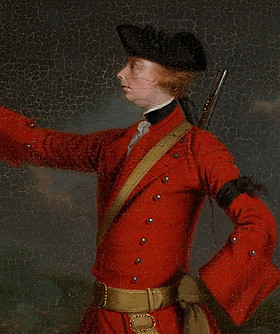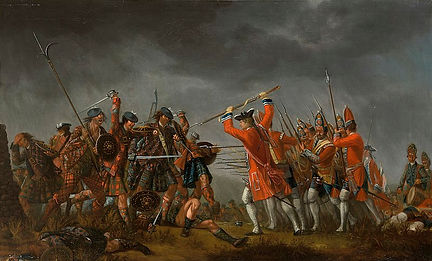

17th REGIMENT of LIGHT DRAGOONS


On a Field in Canada
Our Story Begins
The history of any regiment is a deeply held treasure in the hearts and minds of its soldiers. And the 17th is no different. And yet it is not a story so simple as to boil it down to a date on a scrap of paper in a museum. Indeed, the 17th owes its entire legacy to a mere fifteen minutes on a field in Canada a full sixteen years before they set foot on the continent.
All Becaue of Two Friends.


James Wolfe
John Hale
John Hale was born in 1728, the fourth and youngest son to Barron Sir Barnard Hale, a lawyer who became the Lead Barron of the Exchequer of Ireland. But Hale never knew his father, who died only a year after he was born m. Though originally attending Caimbridge to follow in his father’s footsteps as a lawyer, his brother convinced him to join the army which he took to with great fervor.
He was only 17 when the last of the Jacobite rebellions broke out in 1745. While fighting the “Bonnie Pretender” and his Jacobite Highlanders, Hale served in the 47th of Foot. At the Battle of Prestonpans, the regiment was decimated by Scottish rebels and nearly all but the unit's colonel were captured. This also meant the regimental colors were taken by the Highlanders, which left such a sour taste in Hale’s mouth that for the rest of his life he would look upon Scotland with distane.
Not much else is known about his service in the ‘45 but by the end of it, Hale had distinguished himself enough to begin rising through the ranks, though his status as the son of a Barron didn’t hurt. By the time he was serving in the Seven Years War, he had risen to the rank of colonel as the British Army pushed its way into Quebec to fight the French at their colonial capital.
James Wolfe, on the other hand, had an altogether different upbringing. Born only a year before Hale, this son of a military man entered his father’s 1st Royal Marine Regiment at the age of 13 and by the age of 17 had attained a second lieutenant’s commission in that regiment. He acquired this just in time to gain a year’s experience and transferred to the 12th Regiment of Foot. He was shipped off to the War of Austrian Succession and stationed for a frustrating, boring year without fighting in Ghent, despite gaining a promotion to Lieutenant.
Finally, Wolfe got to see some action in the Battle of Dettingen under the direct command of King George II. Harsh, desperate fighting resulted in the 12th taking the heaviest casualties of the battle, and Lieutenant Wolfe even had his horse shot out from under him. But the British succeeded in thwarting the attack, and throughout the battle the King’s own son fought nearby the gallant Wolfe, and the Duke would not forget this formidable young officer.
During his time on the continent, Wolfe had risen to the rank of Major and was still garrisoned in Flanders when word came from back home; the heir to the disposed Stuart dynasty of British kings had come back and raised an army of Jacobites in the Highlands of Scotland. In the span of two months the Bonnie Pretender, Prince Charles Edward Stuart, had captured Edinburgh and defeated an army in a place called Prestonpans. The King’s son was immediately recalled to Britain, and with him, he took 12,000 troops, including Wolfe and his regiment.
The Duke pushed the Jacobite army back out of England with the help of Wolfe who was under direct command of a Lieutenant General Henry Hawley. They continued to pursue the traitorous Scots to Inverness where they met for battle on a soggy moor near a place called Culloden. Here the King’s So , the Duke of Cumberland, decimated the Highlander ranks and broke the rebel army completely. As soon as the rebels were subjugated, the army returned to the War of Austrian Succession.
It is not clear when Hale and Wolfe met each other, but by the time of the 7 Years War, the two had become renowned for being quite close as friends and comrades in arms. When France and Britain went to war in 1756, both headed to the colonies to fight the war in French-owned Canada, Hale serving under Wolfe as they battled the French General Montcalm for superiority in the Americas.
And this all culminated to a fateful September day outside of Quebec
After laying siege to the city, Wolfe led 4,400, among whom was his friend John Hale, attempted a brazen and harrowing amphibious landing. Quebec was built with part of its geography backing up to steep cliffs along the west side of the city next to the St. Lawrence River. Wolfe took two cannons and his men up the cliff from the river below, surprising the French who never even considered the British crazy enough to try such a feat. It was the morning of September 13th, 1759.
Shocked and terrified that the British had managed to climb an unclimbable cliff, Montcalm knew if they delayed meeting their enemy the British might be able to haul up more cannon and reinforcements. And so Montcalm ordered an attack to take place on the Plains of Abraham.
The battle lasted all of fifteen minutes. Wolfe deployed Hale and the other regiments into a horseshoe shape and had all his troops load two musket balls down their barrels in preparation for the fight.
After nearly a full six minutes of standing in the field in silence, the French were the first to volley. Due to many of the fighters being untrained militia, they were not overly effective.
The British then returned fire. The first volley ripped through the French lines as the second rank marched forward and followed the first volley with another devastating rain of fire, the musket balls ripping through the Frenchmen like a scythe through wheat. According to Captain John Knox of the 43rd Foot, the regiments "gave [the French], with great calmness, as remarkable a close and heavy discharge as I ever saw." The French routed and scattered into the city, being hunted down by the charging regiments of His Majesty.
But as the French retreated, they did not leave without inflicting their
own casualties. When Wolfe began the assault he had moved forward
to a small hill and when the French fired, he took hits from several
musket balls. Shot once in the arm, once in the shoulder, and finally
in the chest, General Wolfe lay in the grass on the Plains of Abraham, dying.
Someone asked if he would have a surgeon; but Wolfe shook his head; he
knew it would do no good. According to eyewitness accounts, an officer
with him at the end looked out at their troops hunting down the
fleeing French.
"See how they run," he said.
"Who run?" demanded Wolfe, the wounds fast sapping the strength from his voice.
"The enemy, sir; they give way everywhere."
"Then tell Colonel River to cut off their retreat from the bridge,” Wolfe murmured, ever the tactician. “Now, God be praised, I die contented.”
As the general lay gasping for his last breath he looked up at the officers gathered around him and made one last request.
“I am aware that is is the aid-de-camp’s privilege to carry dispatches home. But I beg that, as a favour, that my old friend, Colonel Hale, may have that honor.”
By the time Colonel Hale was made aware of the situation, his friend was long dead. Bearing the weight of this important duty, Colonel Hale boarded the frigate Leasthop and made the long journey back to England where he arrived on October 17th, 1759. The grief stricken Colonel accounted to the King the story of Wolfe and his heroism at Quebec, where the victory has sealed the fate of the war and placed the North American Colonies firmly in British hands.
Then, on November 8th, 1759, the King announced that he was charging Colonel Hale with raising a new regiment; a regiment of Light Horse that would honor and memorialize the sacrifice of one of Britain's greatest heros.
That is the story about how one friendship lead to death for one party, and glory for another. And with that glory, John Hale proceeded to influence centuries of military tradition within the British army, all because he chose to use his glory to honor the death of his close friend who fell on the Plains of Abraham.






Gold-Digging Artist
The Dishonorable
There are a few iconic paintings of the Revolutionary War we all know and love. But when it comes to the Seven Years War, or as they say in the former colonies, the French and Indian War, there is one painting that stands out above the rest, and that is Benjamin West’s painting, the Death of General Wolfe.
Benjamin West was born October 10, 1738, near the sleepy town of Springfield in the colony of Pennsylvania. As a young boy he showed such promise in his artistic ability that his family sent him to Philadelphia to study painting. After running a successful portrait business in New York, he went abroad to study in Italy before settling in London and becoming a patron of King George himself as well as being one of the founders of the Royal Academy in 1768.
The Painting of the Death of General Wolfe was completed in 1771 and housed in the aforementioned Royal Academy until it was moved to Canada to recognize their contributions to the First World War. The painting has been a topic of critique since it’s creation, where West deviated from the traditional neoclassic style of painting figures of the era as Roman or Greek mythological figures with ancient dress and symbols, choosing rather to paint the men in the picture in their actual period garb. However he was also criticized for his artistic license, since of the men portrayed at General Wolfe’s death in the painting, only the man holding the flag was present for the event, and several of the men were not at the battle at all.
And it is on this point that an interesting insight
into the composition appears. And it appears
from none other than our own founder,
John Hale; General Wolfe’s comrade in arms.
According to a letter penned by Hales own
daughter, by then a Mrs. Anne Smelt, second
wife of the famous Cornelius Smelt, she
recounted a tale most damning to the nature
of how Benjamin West decided who was to
be captured in his famous painting;
“General Hale’s portrait is not inserted in the
fine print of Wolfe’s Death. And why? Because
he would not give the printer the monstrous
sum of one-hundred pounds, which he demanded as the price of placing on a piece of paper what his country knew very well, that he, General Hale, fought in the hottest of the Battle for Quebec, whether the printer thought fit to record it or not!”
It would seem that Hale would have to pay for the privilege of being included in the momentous work depicting the death of his dear friend. A price which evidently fell short of the price Hale himself put on his honor.
